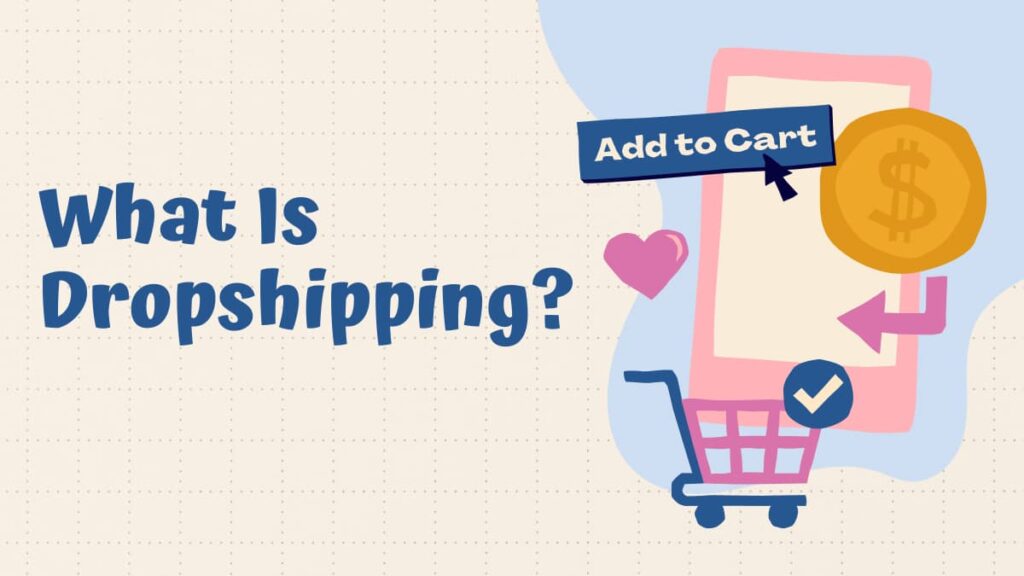Ever wondered how online businesses manage to sell a wide range of products without maintaining a warehouse? They’re likely using a business model known as dropshipping. It’s a low-risk, high-reward strategy that’s shaking up the e-commerce world that has been transformed by digital innovation.
Dropshipping’s popularity is soaring because it’s accessible to anyone with an internet connection. It’s a game-changer for entrepreneurs because it minimizes risk, provides product variety, and requires less capital to start than a traditional retail or eCommerce store.
In this 2024 guide to dropshipping, we delve into what is dropshipping and how it works, and how to get started, as well as take a look into the pros and cons, unravel the intricacies of dropshipping, explore how it’s reshaping the retail landscape, and provide actionable insights on how to leverage this model for online business success.
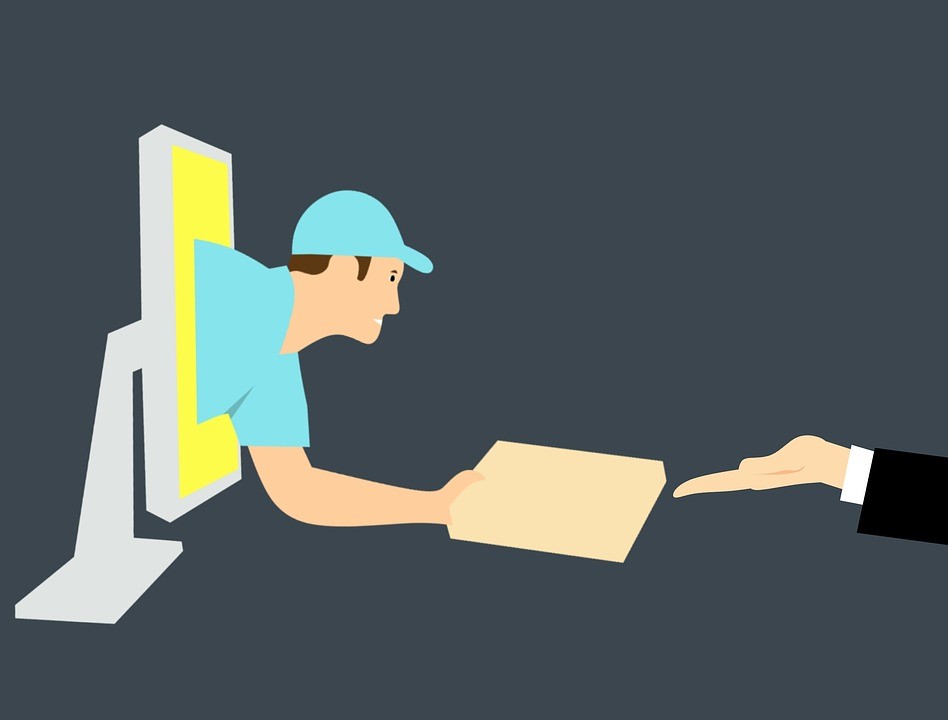
What is Dropshipping?
At its core, what is dropshipping? Dropshipping is a process by which a product is moved directly from the manufacturer to the customer.
Dropshipping is an online business model where sellers do not have to have warehousing inventory. Rather, dropshipping store owners will instead work with third-party suppliers, like sellers on AliExpress, to ship products directly to customers.
This approach significantly diminishes the financial strain that comes with purchasing bulk inventory and handling logistics. Instead, when a customer places an order, the company purchases the product from a third party—usually a wholesaler or manufacturer—and has it shipped directly to the consumer.
This mitigates risk and cuts down upfront capital requirements, making dropshipping an attractive option for newcomers to the online retail space. Through dropshipping, businesses can offer a wide array of products to their customers, while the suppliers handle the stock and shipping complexities, allowing dropshipping entrepreneurs to focus on market trends, customer relationships, and brand building.
While is sounds pretty straightforward, there is a catch: it’s not just about posting some products online and watching the dollars roll in. Like anything in life, dropshipping requires effort to be successful. It demands product research, supplier hunting, customer service commitment, marketing expertise, and most importantly, perseverance.

How Does Dropshipping Work
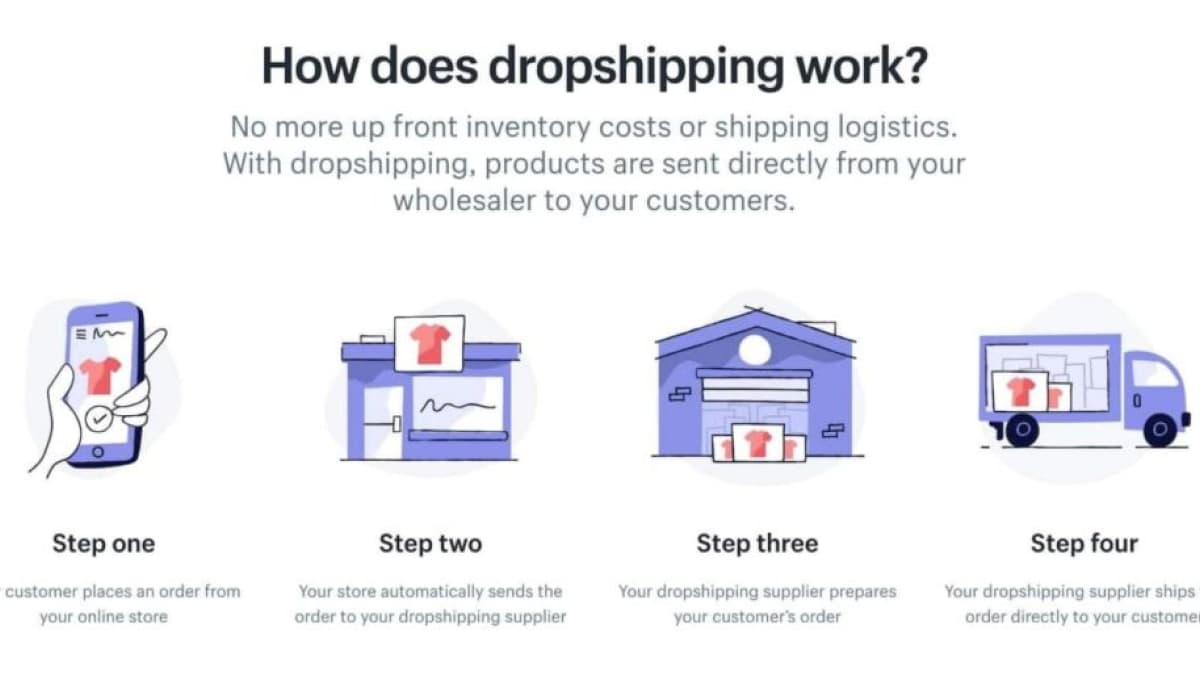
Step One: Customer Places an Order
It all starts with the customers. They visit your online store, scour through the virtual aisles, and finally pick out something that catches their fancy. They add it to their cart and complete their payment. Bingo! An order is placed.
- Customers do not know that you’re dropshipping.
- Successfully running an online store is what draws customers in.
- Good eCommerce practices turn first-time customers into repeat customers.
Step Two: Automatic Order Forwarding to the Supplier
Once that order is finalized, it’s time for some behind-the-curtains action. You’ll need to forward this order to your dropship supplier. Here’s where an automated system can be a lifesaver. It’ll take the details from the order and send them directly to the supplier in no time. Smooth, efficient, and builds seamlessly on the back of modern technology.
- An automated system is your best bet for efficiency.
- Automation eliminates the need for manual entry, reducing chances of error.
Step Three: Order Preparation and Fulfillment by the Supplier
Your selected dropship supplier then takes over. They retrieve the product from their storage, package it up, and prepare it for shipping – all without any physical intervention from your end. This is where your trust in your supplier is truly tested, because it’s their responsibility to ensure the product reaches the customer in top-notch condition. Since the supplier directly influences the customer experience at this stage, choosing both a reliable and efficient dropshipping supplier is vital for your business’s reputatio
- The right supplier can make or break your business.
- Always ensure you have a trustworthy and reliable supplier.
Step Four: Direct Shipping to the Customer
Finally, your supplier will ship the packed product directly to the customer. After the order is packed and ready, the dropshipping supplier dispatches it directly to your customer. The supplier uses their own shipping and logistics services to send to order to the customer.
This step bypasses the traditional retail model where products are first sent to the retailer and then to the customer, saving time and reducing shipping costs. The supplier typically provides tracking information, which can be passed on to the customer, allowing them to track their shipment’s progress. They won’t even know it’s come via a different route! The package will be sent using a blind shipping method, which means there’ll be no trace of the supplier anywhere on the packaging.
This direct shipping model is the cornerstone of dropshipping, as it minimizes the retailer’s need to maintain inventory or handle logistics, allowing you to focus on marketing and customer service
- Blind shipping maintains the invisibility of the supplier to the customer
- Maintaining this illusion is key for a successful dropshipping business
Dropshipping – Pros and Cons
Pros:
Low Overhead Costs
The most significant advantage of dropshipping is the low overhead costs. Since you’re not purchasing inventory up front, there are no storage costs associated. Likewise, you don’t need to worry about warehouseing or shipping fees. This benefits small businesses especially, allowing them to get started without a significant monetary investment.
Low Barriers to Entry
Another pro of dropshipping is the low barriers to entry. It’s relatively easy to set up an e-commerce store, add products, and start selling. In fact, you can launch a dropshipping business with nothing more than a laptop and an internet connection. If you are not sure if dropshipping is right for you, you can always test dropshipping for free.
Ability to Sell on Many Channels and Platforms
Dropshipping businesses don’t have to confine themselves to one website or platform – you can expand your digital presence on platforms like Shopify, Amazon, and AliExpress among many others, increasing your overall visibility and opportunities to make sales.
It’s Scalable
Dropshipping is scalable. As your business grows, you won’t need to worry about outgrowing your warehouse space or hiring more staff to manage inventory and shipping. And, you can work with multiple suppliers, invest as much as you want in your digital marketing and ad campaigns, and sell as much as you want when you are dropshipping on Shopify. When you don’t have to handle product inventory and delivery on your own, this opens up a world of possibilities for scaling, and you could find yourself becoming the owner of a huge e-commerce brand.

Cons:
High Competition
However, this business model isn’t without its cons. Because it’s such a lucrative side hustle option with low starting costs, finding a unique niche can be challenging. And, one of the primary disadvantages of dropshipping is the high competition. Since dropshipping is such an accessible business model, many entrepreneurs are using it, making it harder for you to differentiate yourself and stand out. Don’t let this deter you from starting out, though – dropshipping is still a great way to succeed as an online entrepreneur and it just means you have to put the work in to achieve the results you want to see.
Less control over product quality and delivery time
You’ll have less control over shipping times, which can impact customer satisfaction. Since you’re not handling shipping directly, if your suppliers encounter problems, your business could suffer. Even if customers find fault with the products and it’s the fault of the supplier, you’ll still have to take responsibility as the brand that sold the product to them, so be prepared to manage customers’ expectations and support them through their needs even after receiving their products.
Lower Margins
One of the main drawbacks of dropshipping is the lower margins. Because suppliers are handling storage and shipping, they often charge higher prices for their products, which can eat into your profit margins.
Lack of differentiation
If you want to start a unique business, you’re not likely to find that as a dropshipper on Shopify or AliExpress. Since you don’t physically handle the products, it’s harder to offer unique packaging, insert personalized messages, or provide other differentiation features that help create a strong brand identity. Many products sold by dropshipping stores on Shopify are very alike in nature and it can be difficult to differentiate your brand and sell a unique offer.

Why Should You Get into Dropshipping?
Ease of Entry: Low Cost, High Reward
Traditional businesses, including brick-and-mortar brands, have typically required large amounts of capital to kick start. One of the most attractive features of dropshipping is its ease of entry. Overhead costs are unusually low compared to traditional businesses. You don’t need a brick-and-mortar store, warehouse or upfront inventory. Your primary costs will be setting up your website and marketing your products.
You can instantly pick from a range of suppliers on places like AliExpress, set up a website with tools like Shopify, and execute digital marketing campaigns to increase sales. It really is that simple, and it’s easy to see why dropshipping has proven to be an enduring business model that is, more likely than not, here to stay.
Adapt to Change Swiftly
In the past, business owners had few options for when products were not selling well. They often had loads of inventory left to collect dust in warehouses, taking up space and incurring huge losses for unprofitable businesses. When you’re not tied down with stock, you can adapt to market changes swiftly.
Spot a new trend? Add it to your store and start selling in no time. With dropshipping, you’re better positioned to evolve and stay relevant in a constantly changing market. If a product fails to sell, you can quickly pivot to selling a different one and test out how the market responds to the new product. You can repeat this process as many times as you want, without ever incurring high costs, unlike in the past. This also allows you to be more creative and have fun with the process, letting you try out new strategies and products to see what works and what sticks.
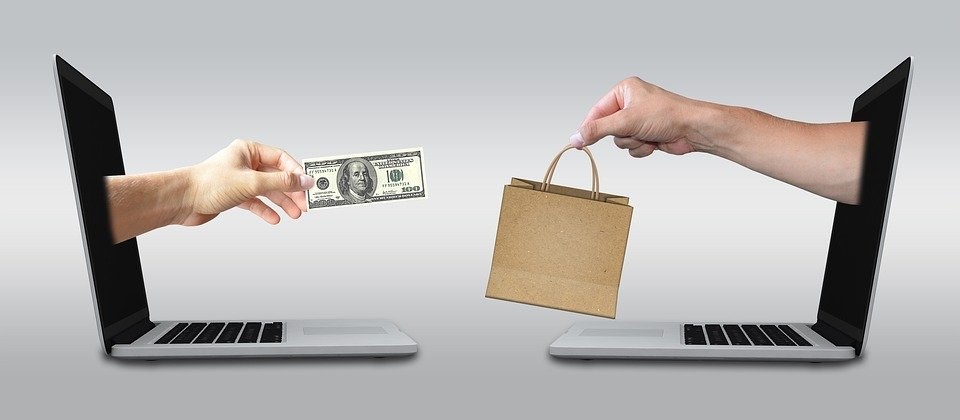
Work Anywhere, at Anytime
The dropshipping model offers you the freedom to run your business from anywhere with an internet connection. Whether you’re at home, in a coffee shop, or traveling the world, your business is right there with you. Plus, you’re not bound by traditional business hours. You can dedicate as much time as you need, whenever you can – a strong appeal to those seeking work-life balance.
Dropshipping is perfect for those who have fallen in love with remote work: you need not work in a fixed location or even at fixed timings. If you operate better at night, that’s fine; if you prefer to get work done in the morning hours, that works out, too. Once your store has taken off and gained momentum, it’s likely to generate a (more than) liveable income that will allow you to bid farewell to your day job. Take back control of your own career and life, one dropshipping sale at a time.
Of course, it’s useful to bear in mind that there’s no one-size-fits-all solution when it comes to entrepreneurship. Each business model comes with its unique pros and challenges, dropshipping is no exception. So take your time, do your homework, and decide for yourself if dropshipping is the fit for you.
How Much Money Do Dropshippers Make?
Some dropshippers can make a few hundred dollars a month while others bring in thousands or even millions. According to the general global dropshipping market statistics, the dropshipping market size is projected to hit $301.11 billion in 2024, and the majority of dropshippers make between 2500 monthly. Yet, highly successful high ticket dropshippers have reported turnovers of $100,000 or more yearly!
| Dropshipper Type | Average Monthly Income |
| Beginner | Less than $500 |
| Novice | 2,500 |
| Successful | Over $5,000 |
| Highly successful | Over $10,000 |
But remember, this is just an average representation. Your earning potential in dropshipping is largely determined by your effort, skills, business strategy, and market trends. You might earn less or more based on these variables. It’s not just about finding a product with high demand; it’s also about presenting and marketing the product effectively. Additionally, customer service and shipping speeds play a crucial role too.
Let’s also bear in mind the costs to start dropshipping that have to be deducted from these earnings. You’ve got your website costs including hosting and domain fees, advertising expenses, taxes, and of course, the cost of goods sold. So, while it might sound delighting to earn big numbers, it’s essential to factor in all these expenses.
What Do You Need to Start Dropshipping?
So, we’ve covered what dropshipping is, debunked some of the common misconceptions, and addressed some of the reasons why you’ll want to get into dropshipping, even when it seems like a saturated market in 2024. If you’re now convinced it’s the right move for you, what then do you need in order to start dropshipping?
Luckily, dropshipping really doesn’t require much. You don’t have to take out a loan at the bank or quit your day job to start. All you really need is a solid plan, settle some legal and insurance matters, find a trustworthy supplier, embark on marketing efforts, and integrate a useful Shopify inspector tool into your dropshipping journey, and you’re good to go.
Here are the 3 key things you will need to start dropshipping in 2024:
Your Dropshipping Business Plan
First and foremost comes your dropshipping business plan. Developing a comprehensive business plan isn’t just paperwork, it’s a roadmap that guides your entrepreneurial journey. As part of this plan, you’ll need to identify:
- Your target market: Who are you selling to?
- Your products: What type of products will you offer and from what niche?
- Your competitors: Who else is selling these products, and how can you differentiate yourself from them?
- Your marketing & sales strategy: How will you reach your target audience and convince them to buy from you?
Start planning for your new dropshipping business if you want to achieve success and establish a clear roadmap, with actionable goals and measurable outcomes to make it all happen.

A Supplier You Can Trust
There are millions of suppliers on marketplaces like AliExpress you can work with.
It can’t be stressed enough how essential it is to have a trustworthy supplier. Your supplier’s reliability directly influences timely deliveries, product quality, and ultimately, customer satisfaction. A poor supplier can damage your business reputation significantly. Therefore, researching and verifying potential suppliers should be a top priority. Always look for supplier reviews, their business registration, and consider ordering product samples to test their reliability.
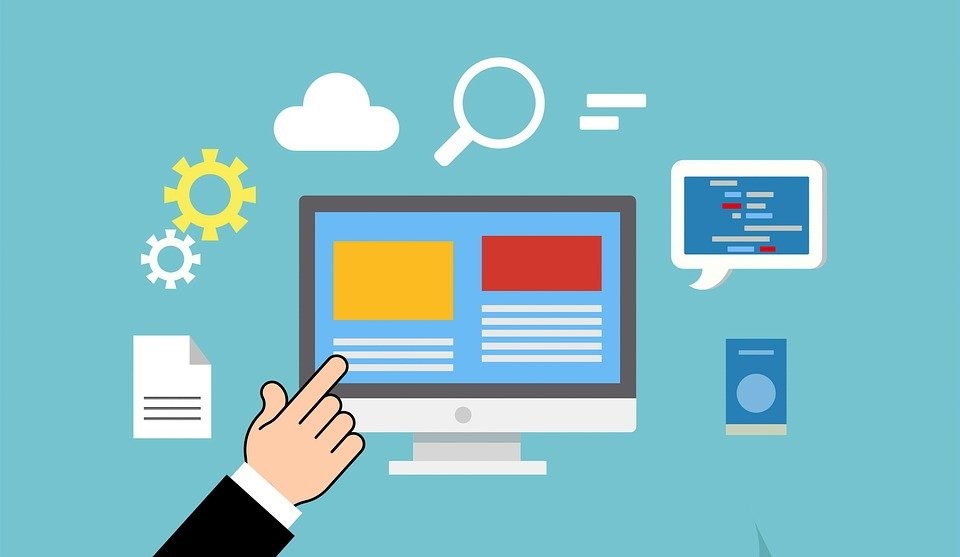
A Reliable Shopify Inspector Tool: Koala Inspector
Find yourself wondering why some of your Shopify dropshipping competitors are thriving and succeeding, while you’re left to decode why your own store is not making money?
Get all the answers you need instantly and make your dropshipping journey a little easier, especially at the beginning, by integrating a reliable Shopify inspector tool into your toolkit of handy resources. With an inspector tool, you will have real-time visibility into Shopify competitors’ stores, their marketing strategy and ad campaigns, product additions and find out what Shopify apps they use to streamline their workflow.
Ideally, the Shopify Inspector Tool you opt for should also come installed with a Shopify theme detector that will instantly reveal what themes your Shopify competitors are using so that you can save time and effort on finding the perfect theme for your store. As a rule of thumb, it would also be best to opt for more minimal themes that are less clunky to reduce dropshipping shop loading time, so that your visitors can access product pages quickly and instantaneously.
The Koala Inspector is the perfect tool for all dropshippers as it comes with the aforementioned functionality, also including functions like compiling Product Lists and the ability to export these lists as CSV files. The Koala Inspector is also free for lifetime use, making it a wallet-friendly Google Chrome extension for dropshipping that you simply won’t want to miss out on. Furthermore, even stacked against competitors like Wappalyzer and BuiltWith, the Koala Inspector has proven itself to be a high-performing tool with all the features a dropshipping store would ever need. Try it out for yourself now!
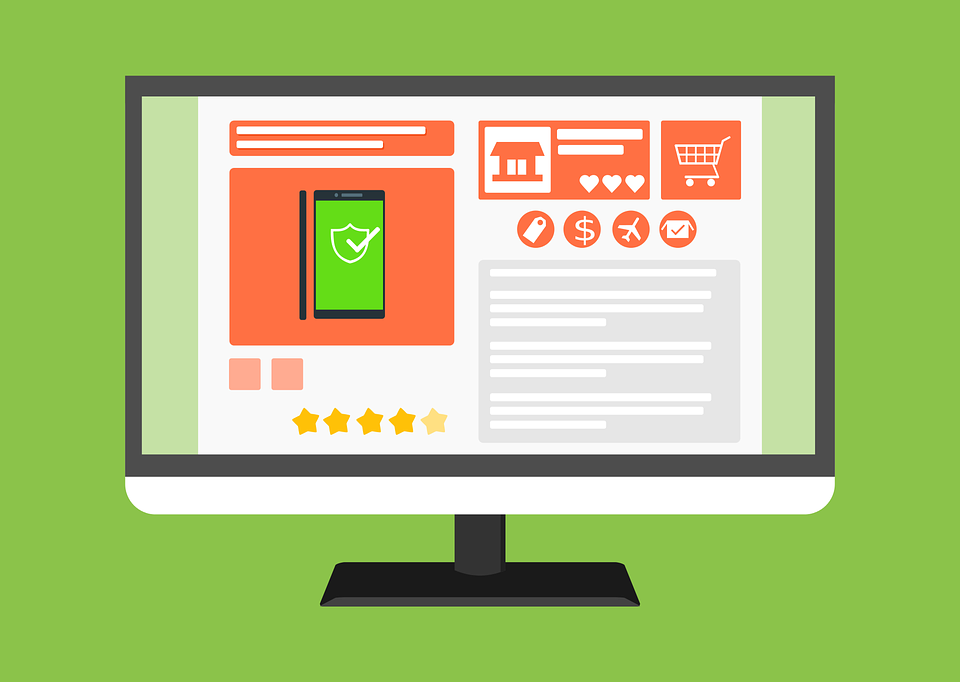
Debunking Misconceptions About Dropshipping
Dropshipping is easy
While dropshipping does eliminate certain tasks like stock management or shipping logistics, it’s not exactly a walk in the park. Competition in dropshipping is fierce, and it requires a lot of hard work and planning to stand out. Developing your unique selling proposition, conducting market research and vendor verification all take time and effort. Yes, dropshipping has its perks but painting it as easy is misleading.It takes time and effort to succeed with this business model, but as long as you’re willing to put the work in and remain patient, you’ll likely see results over the long term.
Is Dropshipping legal?
Far from it. While e-commerce is continually evolving, dropshipping remains vibrant and profitable. Changes in technology, consumer behavior, and market dynamics demand adaptability and innovation, but that’s the case in any business, isn’t it? The key lies in being at the forefront of trends, understanding your customers, and offering value.
Dropshipping is outdated, you’re not likely to make much money from it in 2024
Far from it. While e-commerce is continually evolving, dropshipping remains vibrant and profitable. Changes in technology, consumer behavior, and market dynamics demand adaptability and innovation, but that’s the case in any business, isn’t it? The key lies in being at the forefront of trends, understanding your customers, and offering value.
Dropshipping is a get rich quick scheme
Like any other business, dropshipping demands grit, persistence, and patience. Sure, you might hear stories about people making six figures in a short duration, but remember, they’re the exceptions to the rule. Success in dropshipping tends to result from a well-thought-out strategy, aggressive marketing campaigns, and diligently nurturing customer relationships.
Plus, with so many dropshipping businesses in the market, it’s important to set yourself apart to be able to succeed in the long run. The e-commerce business landscape is starting to get saturated, so you’ll want to put the work in to make sure it all works out great for you in the end. After all, no business owner wants their Shopify store to be a flash in the pan – aim for your business to be profitable for as long as it can be!
Dropshipping only works within your own city or country
On the contrary. The internet has shrunk the world and geographical borders are becoming increasingly irrelevant. Leveraging the global market is one of the advantages of dropshipping. A reliable supplier network can help you deliver products to customers, irrespective of where they are in the world. Don’t limit yourself to just your own region; think big and global with dropshipping.
Dropshipping is a fraudulent business model
Many people who are looking for a profitable side hustle are reluctant to get into dropshipping because they perceive it as a fraudulent business model, and they think of it is being a less valid or legitimate way of conducting business online. This could not be further from the truth! Dropshipping is 100% legitimate and around 27% of online businesses operate as a dropshipping business. Isn’t that shocking?
The high percentage of dropshipping businesses which remain successful and profitable also means that you have most likely bought from a dropshipping store before, whether or not you had known it at that point in time. Like it or not, dropshipping is here to stay, so if you’re interested in getting started, there really is no better time than now.

The Future of Dropshipping: Trends and Predictions
While it’s clear dropshipping continues to hold a strong position as a legitimate and lucrative business model, we should delve into the future of this industry. The global e-commerce market is dynamic, with trends constantly shifting. And dropshipping is no exception.
The main trend I predict for dropshipping is the growing importance of niche selection for success. In the face of increasing competition, choosing a unique, specific niche becomes paramount. It’s all about standing out from the crowd.
Likewise, knowing your customers and their pain points will be more important than ever. This approach, pulled together under the term “customer-centric dropshipping”, relates to tailoring your business around the needs of your customers, not just what you find easier or more profitable.
Next on the docket is sustainability. More and more consumers are becoming environmentally conscious and this will significantly impact the dropshipping world. Businesses maintaining ethical practices, minimizing their carbon footprint, and sourcing from sustainable manufacturers are likely to rise in popularity.
I predict a big surge in AI and machine learning usage. Anticipate these technologies to assist with tasks such as product selection, pricing, and customer service.
We also believe there is a gap in the market for reverse dropshipping, which is a highly lucrative and untapped marketing in 2024. Be sure to check out our reverse dropshipping guide and market analysis if you want to see for yourself.
The biggest innovators in 2024, like augmented reality and AI-driven customer service, will set the stage for a drastic reshaping of this ecommerce model. Understanding these trends is essential not just for the new dropshipper, but for seasoned veterans too.
Final Thoughts
It’s clear that this business model is not only here to stay, but it’s evolving. If you have thought of trying dropshipping out but have never ventured into it fully, or previously had doubts about dropshipping, we encourage you to just give it a shot and try it out. After all, with low overhead and starting costs, dropshipping is a beginner-friendly business model that offers you a great way to learn more about the e-commerce world.
And while you’re at, don’t forget to check out Koala Inspector – the ultimate Shopify e-commerce inspector tool and companion to help you succeed along the way. Reveal Shopify competitors’ secrets, take action, and emerge champion in your dropshipping journey today!

